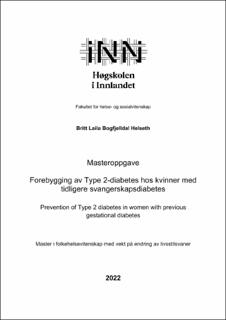Forebygging av Type 2-diabetes hos kvinner med tidligere svangerskapsdiabetes
Abstract
Bakgrunn: Kvinner med tidligere svangerskapsdiabetes (SVD) har en ti ganger høyere risiko for å utvikle diabetes type 2 senere i livet, sammenlignet med kvinner som har normalt glukosenivå i graviditeten. Diabetes type 2 er et stort folkehelseproblem i mange land og økningen i forekomst er en bekymring for helsevesenet verden over. Den store økningen i forekomsten av diabetes type 2 understreker behovet for å revurdere og oppdatere bevisstheten rundt risikoen for å utvikle diabetes etter SVD.
Mål: Målsetningen med denne masterstudien var å undersøke hvordan kvinner med tidligere svangerskapsdiabetes, diabetessykepleiere og fastleger opplever oppfølgingen i svangerskapet, og hvordan de skulle ønske den videre oppfølgingen etter fødsel var mulig å tilby med tanke på forebygging av diabetes type 2 senere i livet.
Metode: Studien har en kvalitativ forskingstilnærming, hvor casestudie ble valgt som studeidesign. Datainnsamlingen besto av ni semistrukturerte individuelle intervjuer; tre kvinner med tidligere svangerskapsdiabetes, tre diabetessykepleiere og tre fastleger.
Resultat: Funn fra studien peker ut to hovedtema med fem undertema. Hovedtema 1 viser til erfaringer og opplevelser med oppfølgingen i svangerskapet, med underkategorier på a) kommunikasjon og samtale og b) etterlevelse av livsstilsråd. Hovedtema 2 viser til oppfølging etter fødsel, men undertema a) utfordringer med timebestillingen, b) kompleksiteten i forhold til livsstilsendring og c) hvordan den videre oppfølgingen bør være.
Konklusjon: Kontakten mellom kvinner og helsepersonell var i hovedsak en positiv erfaring i svangerskapet, mens oppfølgingen etter fødsel var mer utfordrende. Kvinnene opplevde at motivasjon og fokus på livsstil ble overskygget av andre gjøremål med liten baby å ta vare på og husket ikke bestille time hos fastlege etter fødsel. Fastlegene på sin side opplever å ha liten mulighet for en funksjon der de må sørge for å kalle inn personer til kontroll. Kvinnene, fastlegene og diabetessykepleierne peker på flere tiltak, blant annet gjennom muligheten med å benytte kommunale tilbud som helsestasjon eller frisklivssentral. Background: Women with previous gestational diabetes, from now on called GDM have ten times higher risk for developing diabetes type 2 later in life compared to women with normal glucose level during pregnancy. Diabetes type 2 is a major public health problem in many countries and the increase in occurrences is a concern for the healthcare system worldwide. The major increase in occurrences of diabetes type 2 highlights the need to reconsider and update the awareness around the risk for developing diabetes after GDM.
Goal: The objective of this master’s study was to examine how women with previous gestational diabetes, nurses specialized in diabetes and doctors experience the follow-up during the pregnancy, and how they would like the further follow-up after birth was possible to offer regarding prevention of diabetes type 2 later in life.
Method: This study has the approach of qualitative research, and case study was chosen as the study design. The collection of data consisted of nine semi-structured individual interviews; three women with previous gestational diabetes, three nurses specialized in diabetes and three doctors.
Results: Findings from the study points out two main themes with five sub-themes. Main theme number one refers to experiences with the follow-up during pregnancy, including sub-categories on a) communication and conversations and b) compliance of lifestyle advice. Main theme number two refers to the follow-up after birth, including sub-categories a) challenges with the appointment booking, b) the complexity in relation to lifestyle changes and c) how the further follow-up should be.
Conclusion: The contact between women and healthcare workers was mainly a positive experience during pregnancy, whereas the follow-up after birth was more challenging. The women experienced that motivation and focus on lifestyle was submissive by other tasks that comes with a new-born baby and forgot to book an appointment with a doctor after birth. On the other hand, the doctors experience having little opportunity for a function where they have to ensure calling people in for a control. Both women, the doctors and the nurses specializing in diabetes points to several measures, for instance the possibility of using municipal services such as a healthcare centre or a wellness centre.
